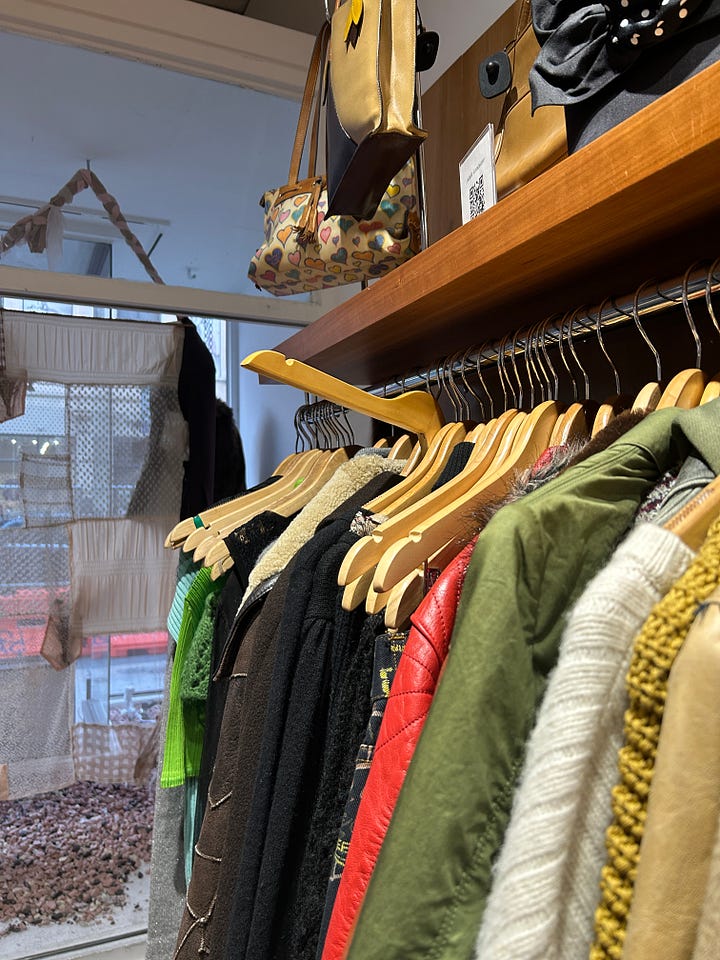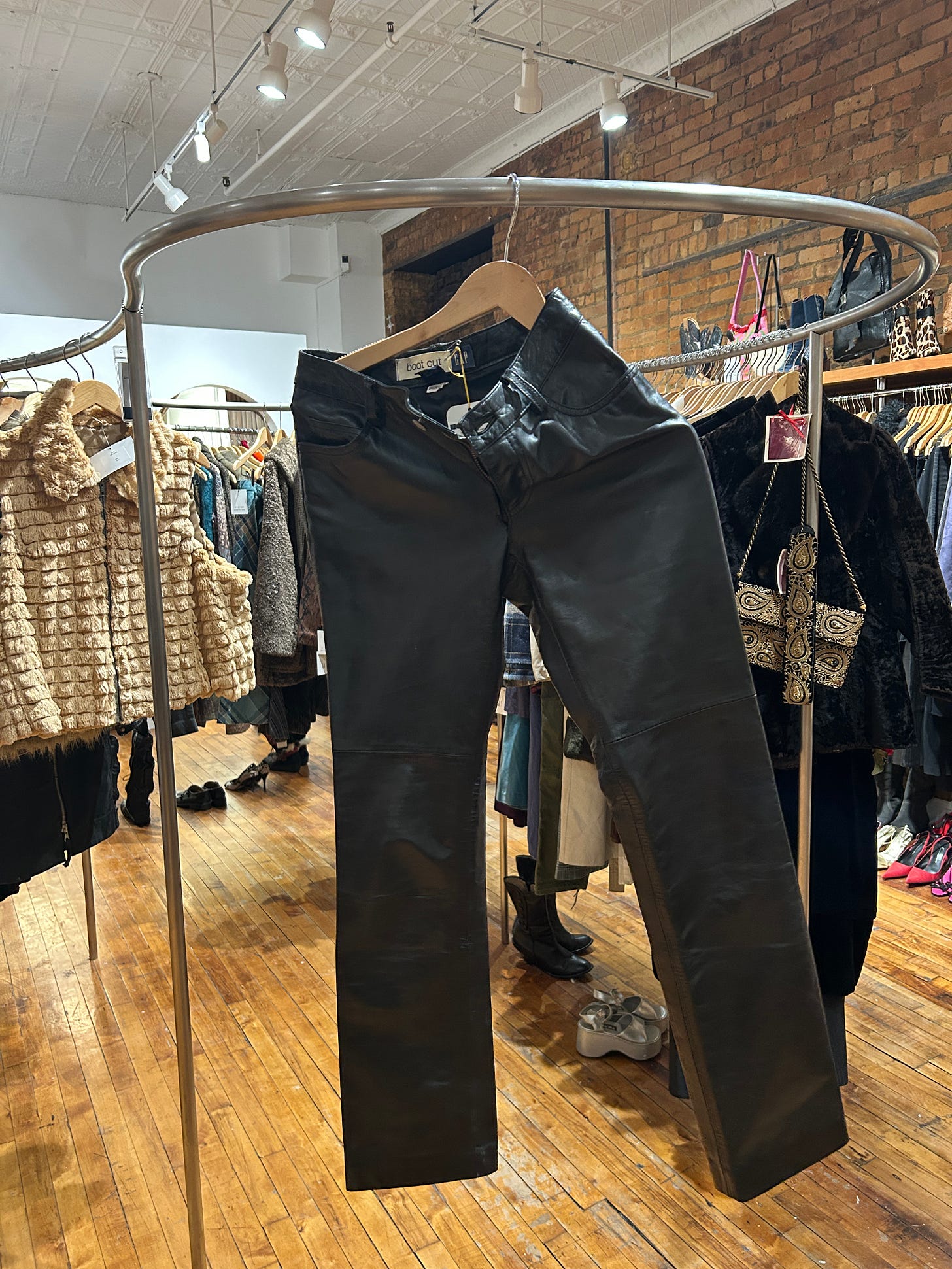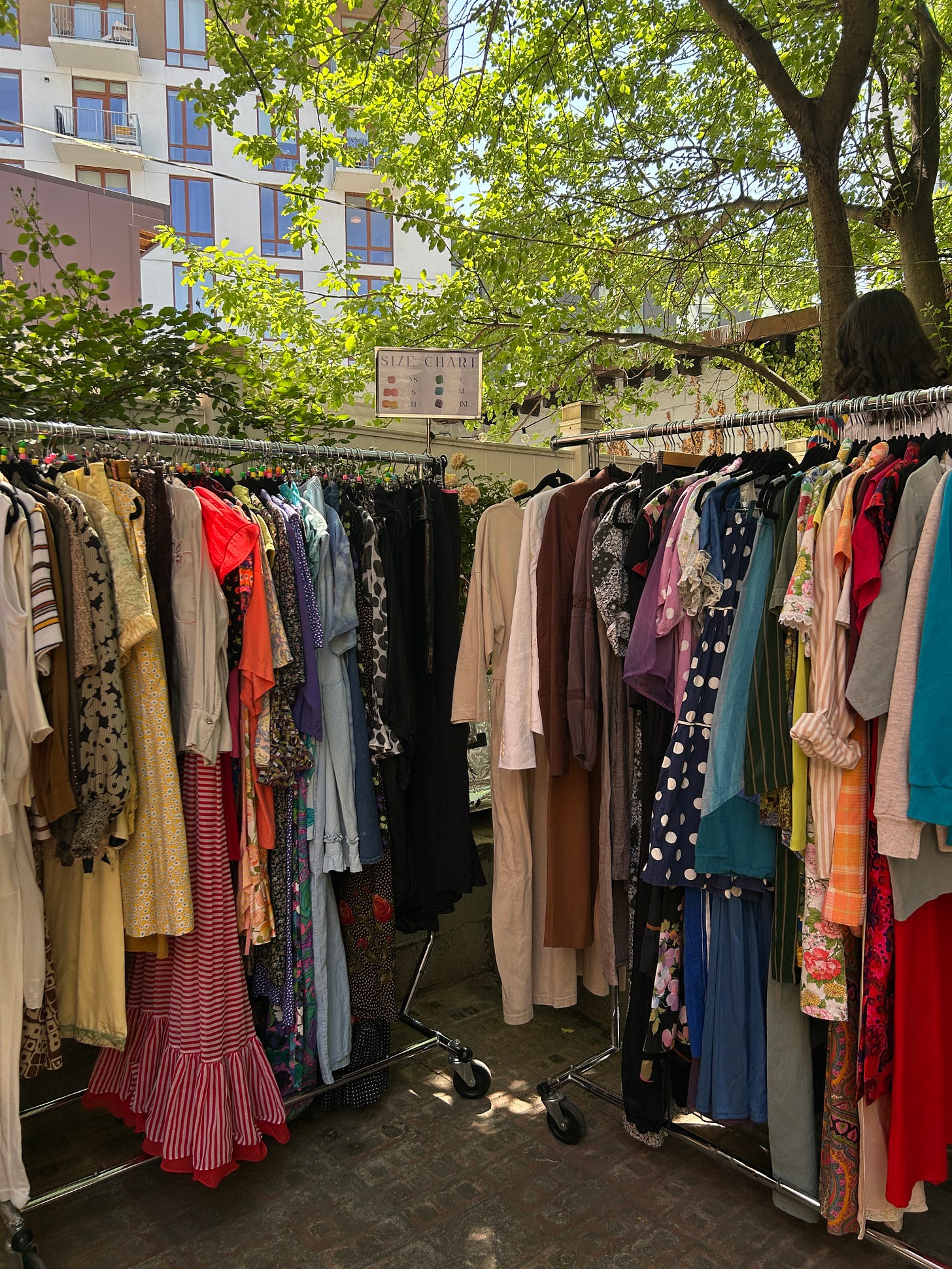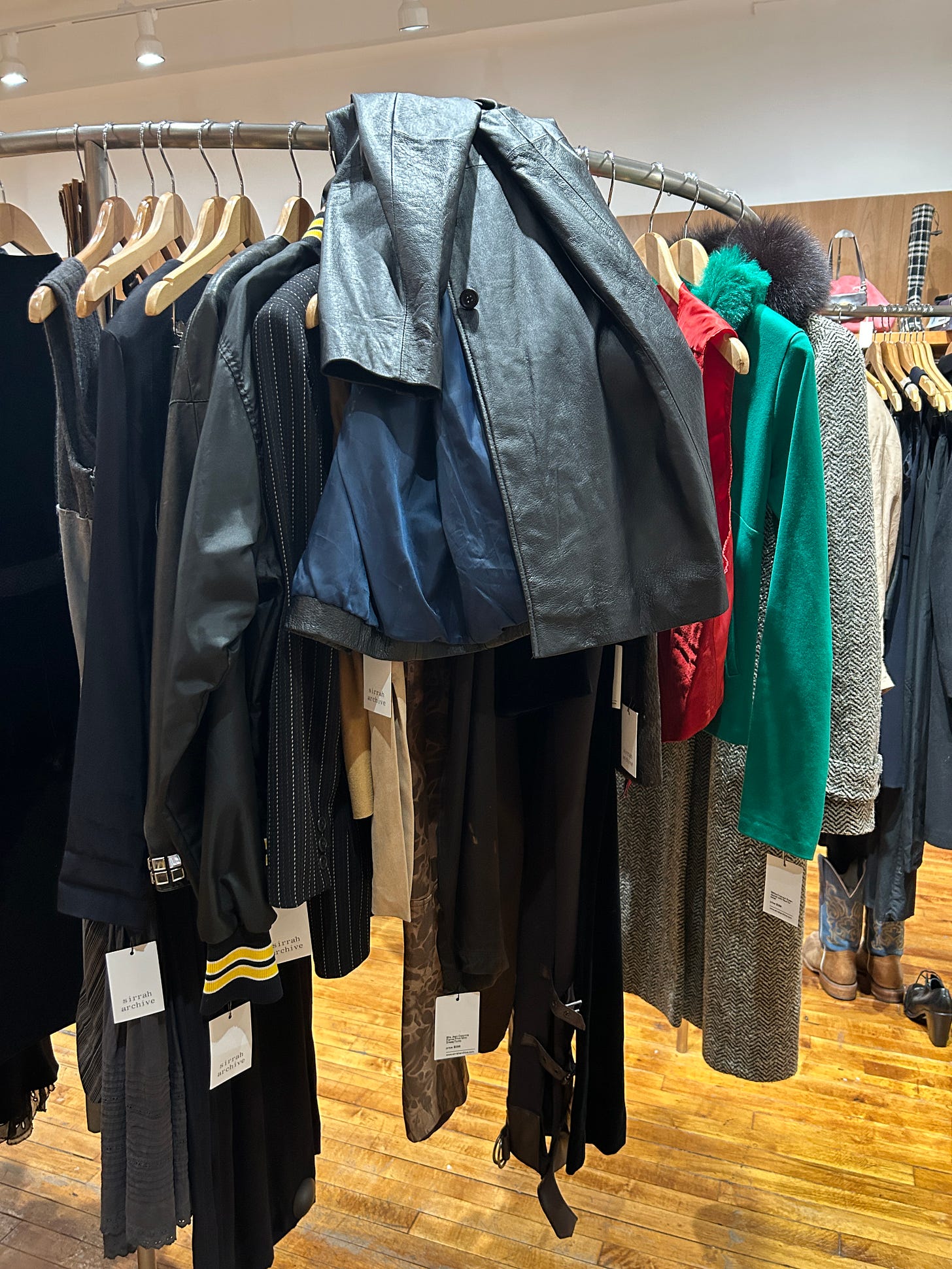You’re probably not an asshole.
Despite working for almost two decades in customer service, I’d like to think that most people aren’t. I’ve seen my fair share of bad behavior, but I genuinely believe that most of it comes down to unawareness and distraction. If you’re stealing from small businesses or bearating workers for sport, please seek help. If you’re just out there trying your best, thank you! There are probably bad shopping habits you’ve picked up anyways due to the declining state of the fashion industry, and you may not even realize it.
After swearing off retail work many years ago, I’ve found myself deeply immersed in an industry that requires the exact kind of customer service that I once so desperately wanted to get away from. The upside of vintage retail is that I’m genuinely passionate about the product, and there’s a truly one-of-a-kind community of fellow dealers, collectors, and shoppers. The downside of vintage retail is that it’s still retail.


After a few particularly grueling shifts at the vintage store, I decided to put together a list of some of the most common blunders I see amongst vintage shoppers. The fact that you’re here reading this probably means you’re not behaving badly on purpose! I wouldn’t expect most people to know exactly how to square fold a sweater or unhook a 1950’s necklace clasp. But unlike shopping at a contemporary clothing store, secondhand sales present a unique set of challenges. Vintage means no restocking, no size runs, no “getting another one from the back.” Pieces are typically one of one, and dealers and shopkeepers invest huge amounts of time, care, and labor to offer a special curation of unique pieces. Vintage pieces usually can’t be replaced when they’re damaged or stolen, which means shopping with care is more important than ever.
What Not to Do
1. Pull on the fabric
When you’re browsing through hanging clothing, you probably look through the items piece by piece, pushing the garments along the rack as you go. When you’re doing this, don’t move the clothing by pulling on the fabric of the clothes themselves - use the hangers! Pushing or pulling on the hanger is much less likely to damage the clothes. There’s a specific feeling of dread that comes from watching someone yank on delicate lace or finely woven knitwear by the sleeve. While vintage garments are typically very well made, they are also old! One person pulling on a 60-year-old seam probably won’t hurt, but dozens of people doing it day after day will eventually cause damage that can be expensive (or worse, impossible) to repair.
2. Hang things back up incorrectly
If you’re in a fitting room, it can sometimes to be tricky to figure out how a piece was on the hanger before you tried it on. I get it! If you’re unsure, I’d always prefer you leave an item neatly placed on a stool/bench or just hand it directly to an employee. Haphazardly throwing a garment back on a hanger inside out or lopsided is actually just more work for everyone (including you!), and can risk damaging the garment.



If you pull a piece off the rack just to look, it only takes a few seconds to hang it back up the way you found it. This means facing the same direction as the other garments on the rack, and with the top of the hanger in the same alignment as the other hangers. This makes the piece easier for the next shopper to look at and take out, it helps garments from getting tangled up, and is one less task for shopkeepers to worry about so they can focus on helping customers. This one isn’t that big of a deal, but it takes barely any time or effort on your part!
3. Openly criticize the product, the prices, or the sellers
Y’all, this is just plain rude. It feels like common courtesy, but I’ve heard so many awful comments about both my own pieces and other dealer’s pieces very much in earshot of the seller. And in almost every single instance of this, I’m hearing criticism from someone who is (often unknowingly) admitting that they know very little about the industry they’re complaining about. If you don’t like the piece or the price, don’t buy it. Sure, there are scammers in every industry, but a large majority of vintage pieces are presented with intention!

Not only is this kind of comment disrespectful and disheartening to the seller, but it does you no favors as a buyer. Retail workers love to gossip! Just because you don’t like the items at this booth or in this store, it doesn’t mean you won’t fall in love with something on the next rack or in the shop across the street. The vintage community sticks together, and most of us offer our best deals to our kindest shoppers. I’m willing and ready to go above and beyond for customers until they’re rude to me or my friends, and most of my fellow dealers and shop workers will say the same.
4. Shop with a “price over everything” mentality
I occasionally overhear people telling a friend they’ll just “find it on eBay for cheaper,” or see someone pick up an item to clearly take a photo of it in Google Lens. You’re well within your right to do either (if the store/event allows photos!), but any price discrepancies you may find are often there for a good reason. There are big differences between your shopping experiences at a market, at a store, in a thrift, or on an app. Sometimes it’s as simple as the fact that online listings don’t need to cover the same overhead as an in-person store, or the fees of a market. However, that piece in front of you often offers a lot that Depop or Etsy doesn’t: you can inspect the condition for yourself, you can feel it and try it on, you can take it home now and wear it to dinner tonight, and you can have a real life conversation with the seller.
I am a very seasoned online shopper, and I still get burned. Weird lighting can make a navy sweater look black, items can be measured or described incorrectly, and bad smells are rarely ever disclosed. That online piece may be “cheaper” than the same piece in store, but how much are you actually saving if you have to mend, dry clean, or straight up resell it?
What You Should Do
1. Ask questions!
Confused about how the ties on a dress work? Want to know the best way to wash vintage silk? Can’t reach a pair of boots on a high up shelf? Any good retail experience should include someone who can help you with all of that and more. If the person selling isn’t willing to be helpful and friendly, they don’t deserve your business anyways!
If you’re ever shopping with me, know that I’m so excited for any opportunity to help you with styling, give you a backstory on an item, or send you to my amazing neighborhood tailor. I frequently recommend other sellers and shops if you’re on the hunt for something special, and absolutely love helping you decide where you should go for dinner.

2. Treat everything (and everyone) with care
Especially when it comes to vintage. Shopping is a great privilege! The fact that hundreds of years of pieces can be presented to you all in one place, ready to wear, is pretty magical. It takes a lot of work to make that happen, and your appreciation for that work goes a long way. And this doesn’t just apply to sellers, but your fellow shoppers! Give people personal space, ask for help with fitting rooms instead of barging in, hold the door. Moving through the world with kindness and respect is always the answer.
3. Pay attention!
So many of the bad behaviors I see shoppers engage in are simply a product of distraction. The modern shopping experience is distracting by design! Contemporary fashion brands are vying for your attention in every way except actually providing high quality products, and the smoke and mirrors have proven an extremely effective method of avoiding customer scrutiny. Who can bother inspecting shoddy sewing and crappy fabric blends when there’s a live DJ, free tote bags, and a photo booth?!
Shopping is often overwhelming and overstimulating, a formula that makes it easy to let some common sense go out the window. Remind yourself to slow down, and take stock of yourself and your surroundings. Ask if you can set down your bags or your drink somewhere to avoid spilling, or knocking something over with your purse. Watch where you step, shoes are often merchandised on the floor underneath racks. Take your time to try things on gently and properly so you aren’t smearing makeup on the fabric or stepping on the hems.
I frequently see these kind of missteps happen when shoppers are rushing, carrying too many bags, or on a phone call. There’s often a simple solution to help you focus on what you’re doing, and the shopkeeper would much rather hold your coffee than watch you spill it on their vintage shoes.
Shop keepers, retail workers, and vintage dealers - what common shopper struggles did I miss? Chime in!






OMG I was literally just having a conversation with a friend who owns a vintage store. She calls these shoppers "new earthlings". Recently, someone spilled a whole iced matcha on a table of vintage denim in her shop and didn't even tell her. SMH.
i would add: if a shop/dealer policy or rule frustrates/confuses you, ask about it before complaining. there's a reason that policy is in place, i promise people are not trying to be overbearing or control-freaky!!